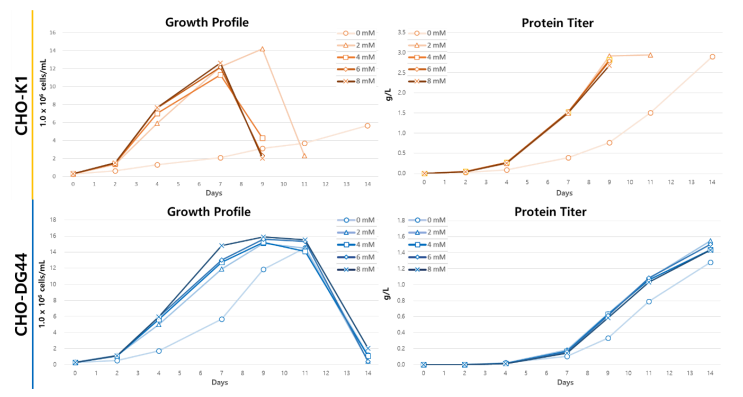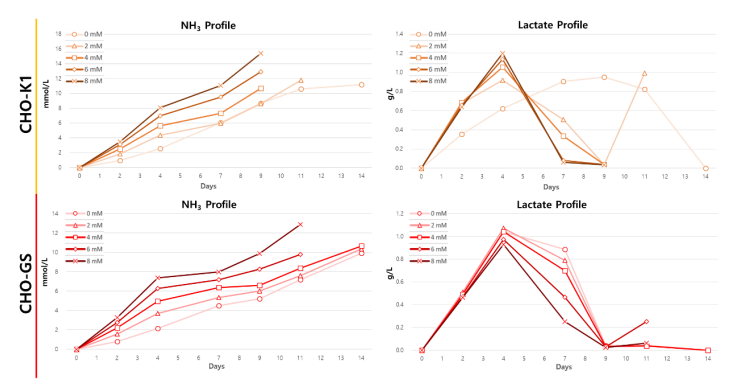[CELLiST] 배지 사용에 필수적인 보충제
페이지 정보
작성자 ajinomo 조회 4,012 작성일 23-10-30 17:26본문
Application Note: L-Glutamine Supplementation in CHO Cell Culture
Background
L-glutamine is an essential amino acid often used to support the growth of CHO cell cultures. Glutamine supports the growth and protein production of cells that have high energy requirements and high protein production. It is an essential nitrogen source for buildign upmolecules such as nucleotides,
amino acids and vitamins. However, L - glutamine is unstable at physiological pH in liquid media. That is why it is often added to the media right before the inoculation of cells. Alternatively, glutamine dipeptides such as Alanyl-Glutamine with higher stability (for example, Ajinomoto’s AminoStable™) can be used to ensure sustainability of the glutamine source. Additional consideration to be taken into account when using an L-glutamine source is the
production of ammonia, which at high concentrations can be detrimental to culture growth (See ‘Note on Toxic Byproducts’ on Pg. 3).
amino acids and vitamins. However, L - glutamine is unstable at physiological pH in liquid media. That is why it is often added to the media right before the inoculation of cells. Alternatively, glutamine dipeptides such as Alanyl-Glutamine with higher stability (for example, Ajinomoto’s AminoStable™) can be used to ensure sustainability of the glutamine source. Additional consideration to be taken into account when using an L-glutamine source is the
production of ammonia, which at high concentrations can be detrimental to culture growth (See ‘Note on Toxic Byproducts’ on Pg. 3).
Effect of L-Glutamine Supplementation on Growth and Productivity
The graphs below present growth profiles in terms of viable cell density (VCD), as well as productivity (protein titer), for two cell lines, CHO-K1 and
CHO-DG44. Significant effect of L-glutamine addition can be seen, especially in the case of CHO-K1. Here, even the lowest dose of 2mM L-glutamine (triangles), added on Day 0 of the culture, led to rapid cell growth and transition to exponential growth phase (CHO-K1, top-left graph, Day 2-4), while in the case of no L-glutamine addition (circle) biomass growth was extremely slow and did not reach transition to exponential growth phase with in the
two weeks of culture. Correspondingly, the amount of protein produced is greatly influenced by the culture growth, as can be seen on the top right-side graph: protein titer at Day 9 is over 3 times higher when L-glutamine was supplemented compared to the case with no glutamine addition. In the case
of CHO- DG44 cell line (bottom graphs), although the effect of L-glutamine supplementation is less substantial, it did allow quicker transition to
exponential growth phase, and the overall protein titer was increased by ~20% (2 mM) compared to the case of no glutamine addition (lower-right
graph). It is also important to note that supplementing too much L-glutamine can be detrimental to culture growth, as seen in the top-left graph for
CHO-K1 line: optimal growth was observed for 2 mM L-glutamine, while larger doses led to earlier decrease in cell density.
CHO-DG44. Significant effect of L-glutamine addition can be seen, especially in the case of CHO-K1. Here, even the lowest dose of 2mM L-glutamine (triangles), added on Day 0 of the culture, led to rapid cell growth and transition to exponential growth phase (CHO-K1, top-left graph, Day 2-4), while in the case of no L-glutamine addition (circle) biomass growth was extremely slow and did not reach transition to exponential growth phase with in the
two weeks of culture. Correspondingly, the amount of protein produced is greatly influenced by the culture growth, as can be seen on the top right-side graph: protein titer at Day 9 is over 3 times higher when L-glutamine was supplemented compared to the case with no glutamine addition. In the case
of CHO- DG44 cell line (bottom graphs), although the effect of L-glutamine supplementation is less substantial, it did allow quicker transition to
exponential growth phase, and the overall protein titer was increased by ~20% (2 mM) compared to the case of no glutamine addition (lower-right
graph). It is also important to note that supplementing too much L-glutamine can be detrimental to culture growth, as seen in the top-left graph for
CHO-K1 line: optimal growth was observed for 2 mM L-glutamine, while larger doses led to earlier decrease in cell density.

Figure 1. Effect of L-glutamine supplementation on CHO culture. Growth profile (viable cell density, VCD) and protein titer throughout fed-batch culture for CHO-K1 and CHO-DG44
cell lines (both are IgG1-producing cell lines),at different concentrations of L-glutamine supplmentation. L- glutamine was added one time, in Day 0,at concentrations of either 0
(circle), 2 mM (triangle), 4 mM (square), 6 mM (diamond) or 8 mM (‘x’). Media used: CELLiST™ BASAL3 and FEED2 (feed added on days 4, 7, 9, and 11 at 6% for CHO-K1 and 4% for CHO-DG44 cell line). Culture was stopped when viability dropped below 70%.
cell lines (both are IgG1-producing cell lines),at different concentrations of L-glutamine supplmentation. L- glutamine was added one time, in Day 0,at concentrations of either 0
(circle), 2 mM (triangle), 4 mM (square), 6 mM (diamond) or 8 mM (‘x’). Media used: CELLiST™ BASAL3 and FEED2 (feed added on days 4, 7, 9, and 11 at 6% for CHO-K1 and 4% for CHO-DG44 cell line). Culture was stopped when viability dropped below 70%.
CHO-GS Cell Lines (glutamine synthetase selection system)
Cell lines that incorporate the glutamine synthetase (GS) selection system (often termed ‘CHO-GS’, or CHOZN® lines) usually produce enough
amount of endogenous L-glutamine to sustain their growth. The GS enzyme plays an essential role in the metabolism of nitrogen by catalyzing the
condensation of glutamate and ammonia to form glutamine. In this cell line, depending on the specific characteristics of the clone (such as copy
number, etc.), addition of exogenous L-glutamine source is usually not required. However, as can be seen in the graph below for a CHO-GS line, L-glutamine supplementation (2-4 mM) can lead to a marginal increase in the overall titer.
amount of endogenous L-glutamine to sustain their growth. The GS enzyme plays an essential role in the metabolism of nitrogen by catalyzing the
condensation of glutamate and ammonia to form glutamine. In this cell line, depending on the specific characteristics of the clone (such as copy
number, etc.), addition of exogenous L-glutamine source is usually not required. However, as can be seen in the graph below for a CHO-GS line, L-glutamine supplementation (2-4 mM) can lead to a marginal increase in the overall titer.

Figure 2. Effect of L-glutamine supplementation in CHO-GS cell line. Growth profile (viable cell density, VCD) and protein titer throughout fed-batch culture for IgG-producing
CHO-GS cell line, at difference concentrations of L-glutamine supplementation. L-glutamine was added one time, in Day 0, at concentrations of either 0 (circle), 2 mM (triangle),
4 mM (square), 6 mM (diamond) or 8 mM (‘x’). Media used: CELLiST™ BASAL3 and FEED2 (feed added on days 4, 7, 9, and 11 at 4% of initial volume). Culture was stopped when
viability dropped below 70%.
CHO-GS cell line, at difference concentrations of L-glutamine supplementation. L-glutamine was added one time, in Day 0, at concentrations of either 0 (circle), 2 mM (triangle),
4 mM (square), 6 mM (diamond) or 8 mM (‘x’). Media used: CELLiST™ BASAL3 and FEED2 (feed added on days 4, 7, 9, and 11 at 4% of initial volume). Culture was stopped when
viability dropped below 70%.
Conclusion
Because its importance in cell growth and function, and due to the difference in glutamine requirements between cell lines, it is important to optimize
glutamine supplementation per cell line. In general, it is recommended to add glutamine for encouraging culture growth, especially when
performing cell adaptation, or when switching from one culture medium to another, as this will support the cells in their adaptation to the new medium. For example, when switching to CELLiST™ media, we recommend supplementing the cell culture with 2-4 mM of L-glutamine, to ensure smooth
transition and proper adaptation of your cell line to the new CELLiST™ medium. As mentioned previously, consideration should be taken not to
overfeed the culture with of L-glutamine source, as this can lead to excess in ammonia production, which can be detrimental to cell growth.
glutamine supplementation per cell line. In general, it is recommended to add glutamine for encouraging culture growth, especially when
performing cell adaptation, or when switching from one culture medium to another, as this will support the cells in their adaptation to the new medium. For example, when switching to CELLiST™ media, we recommend supplementing the cell culture with 2-4 mM of L-glutamine, to ensure smooth
transition and proper adaptation of your cell line to the new CELLiST™ medium. As mentioned previously, consideration should be taken not to
overfeed the culture with of L-glutamine source, as this can lead to excess in ammonia production, which can be detrimental to cell growth.
Note on Toxic Byproducts (Ammonia and Lactate)
Below graph shows ammonia and lactate levels for two cell lines, CHO-K1 and CHO-GS. As can be seen, ammonia concentrations are directly
correlated with L-glutamine supplement concentrations. However, at L-glutamine concentrations of 2-4mM, increase in ammonia levels is minimal and would have little detrimental effect on culture growth. As for lactate (right side), it can be seen that for CHO-K1 line addition of as little as 2 mM
L-glutamine would lead to proper growth and lactate profile, with lactate consumption taking place after Day 4. In the case of no glutamine addition,
culture growth is slow and lactate continues to accumulate beyond Day 7.
correlated with L-glutamine supplement concentrations. However, at L-glutamine concentrations of 2-4mM, increase in ammonia levels is minimal and would have little detrimental effect on culture growth. As for lactate (right side), it can be seen that for CHO-K1 line addition of as little as 2 mM
L-glutamine would lead to proper growth and lactate profile, with lactate consumption taking place after Day 4. In the case of no glutamine addition,
culture growth is slow and lactate continues to accumulate beyond Day 7.
In the case of CHO-GS, the effect of L-glutamine supplementation is minimal and does not have much effect on culture growth and lactate profile.
However, higher concentrations of glutamine will lead to higher ammonia levels, which are toxic and can be detrimental to culture growth (lower-left
graph). This can also be seen in Figure 2 (left graph), where higher doses of L-glutamine (6 and 8mM) lead to reduced cell growth and productivity.
However, higher concentrations of glutamine will lead to higher ammonia levels, which are toxic and can be detrimental to culture growth (lower-left
graph). This can also be seen in Figure 2 (left graph), where higher doses of L-glutamine (6 and 8mM) lead to reduced cell growth and productivity.

Figure 3. Effect of L-glutamine supplementation on ammonia (NH3) and lactate profiles in CHO-K1 and CHO-GS cell line.
Concentrations of the two byproducts are shown at difference doses of L-glutamine supplementation. L-glutamine was added one time, in Day 0, at
concentrations of either 0 mM (circle), 2 mM (triangle), 4 mM (square), 6 mM (diamond) or 8 mM (‘x’). Media used: CELLiST™ BASAL3 and FEED2
(feed added on days 4, 7, 9, and 11 at 6% for CHO-K1 and 4% for CHO-GS cell line). Culture was stopped when viability dropped below 70%.
concentrations of either 0 mM (circle), 2 mM (triangle), 4 mM (square), 6 mM (diamond) or 8 mM (‘x’). Media used: CELLiST™ BASAL3 and FEED2
(feed added on days 4, 7, 9, and 11 at 6% for CHO-K1 and 4% for CHO-GS cell line). Culture was stopped when viability dropped below 70%.
Attached Files
- 05. CSC_technote_Glutamine Application Note.pdf (935.9K) 11회 다운로드 | DATE : 2024-05-08 21:10:07
댓글목록
등록된 댓글이 없습니다.



 SAMPLE
SAMPLE